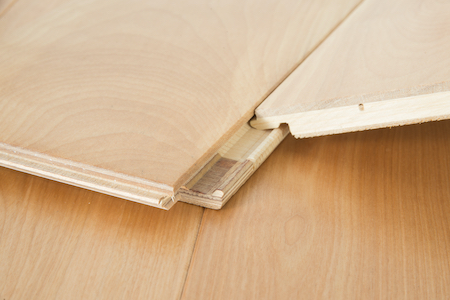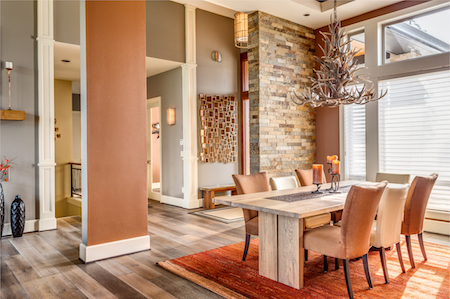The Ins and Outs of a Floating Floor
Floating floors are increasingly popular in homes across Colorado. The term “floating floor” doesn’t represent a specific type of flooring or material; rather, it refers to a method of installation. You’ll find many different materials utilize floating floor technology as a means to go in quickly into your rooms: laminates, engineered hardwood, and luxury vinyl all can be installed using click and lock technology.
Floating floors come in individual plank or tile format, with interlocking edge-to-edge form that creates a mat-like surface that lays or rests on the subfloor or underlayment.
It’s quite different than glue-down or nail-down flooring you may have in the rest of your home. It takes time to adhere tiles or planks using glue, ensuring you lay it correctly and it has ample time to dry. Get it wrong, and you’ll be prying it up, replacing it with brand new materials. That can be a waste of time, money, and resources.
Floating floor technology is easier, and is often the perfect choice for do-it-yourselfers. It’s a favorite method because it’s also forgiving. You should have a perfectly prepared subfloor for a solid base, yet it’s easier than ever to lay each plank or tile down, and click it into place.
What does it mean to have a floating floor?
 The term “floating floor” can be a little misleading, as it doesn’t so much as float as it does rest on the subfloor. With a floating floor, you don’t apply adhesive before you lay each tile or plank into place. Instead, you lock each piece in similar fashion to a jigsaw puzzle, building a tight bond as you combine piece after piece. The floor is stable if you prepare the subfloor and it’s free from blemishes and debris. The only difference is it rests on top of the subfloor, stretching across your room from edge to edge.
The term “floating floor” can be a little misleading, as it doesn’t so much as float as it does rest on the subfloor. With a floating floor, you don’t apply adhesive before you lay each tile or plank into place. Instead, you lock each piece in similar fashion to a jigsaw puzzle, building a tight bond as you combine piece after piece. The floor is stable if you prepare the subfloor and it’s free from blemishes and debris. The only difference is it rests on top of the subfloor, stretching across your room from edge to edge.
The benefits are many, including ease of installation, as well as easy maintenance. If you damage one plank, for example, you have the possibility of replacing just the impacted area, rather than prying loose an entire area and having to redo it. That can be a big bonus in busy households where your flooring receives high impact traffic.
Types of floating floors
In every home, the floors you walk and stand on all day are comprised of several layers. The base was designed when your home was built. It has a network of boards and joists that support the overall structure of your home. The subfloor layer protects the base, as well as provides support for the flooring you install on top. The top layer is the flooring of your choice. This is the part you’ll walk on, place your furniture on, and live with for years to come.
Many flooring choices attach the flooring to the subfloor. It stays attached until it is torn out and replaced. Floating floors are different in that the floor and subfloor remain two separate layers. Floating floors are placed on top of the subfloor without being fixed into place.
You’ll find floating technology exists in three separate types of flooring:
Engineered wood – engineered wood is constructed using multiple layers for added strength. Each layer is made out of wood, with the top layer created from a solid wood veneer. This makes engineered wood planks lightweight, durable, and easy to install. The bottom layer is often made from recycled or a pressed wood, which makes it an eco-friendly option.
You can find engineered wood in glue-down and nail-down methods too, but it’s floating floor technology that makes it easy to install, and a particular favorite of do-it-yourselfers.
Laminate – laminate flooring is rarely glued or nailed into place. Instead, it relies on tongue and groove technology to build the floor into one level surface area. Laminate isn’t wood like engineered wood, and isn’t plastic as some people believe. Instead, laminate is created from four core layers:
- Back layer – a product designed to protect against moisture, and used to help balance the flooring
- Core layer – a durable high-density board that further protects from moisture
- Design layer – a high-resolution photograph that gives the product its appearance
- Wear layer – a clear coated layer that protects the surface
Luxury vinyl – luxury vinyl is created in two separate categories, luxury vinyl tile (LVT) is meant to resemble tile, and luxury vinyl plank (LVP) is meant to imitate wood. Both of these products work similarly to engineered wood and laminate in that the planks or tiles float above the subfloor and use tongue-and-groove or click-lock systems to lay the flooring into place. While these products can be glued, floating technology gives you ease in both installation as well as replacement down the road.
What are the pros and cons?
We’ve eluded to the biggest pro for using floating floors: ease of installation. Because they float into place, you don’t have to worry about adhering a board in the wrong area, and having to pry it back up and wasting resources if you change your mind. This can be a cost-effective way to install a floor, no matter what your skillset. Do it yourself, or hire a professional to do it for you; it’s an easy job either way.
While it is important to have your subfloor primed and ready for a new floor to be installed, floating floor is more forgiving as it isn’t permanently attached. Depending on what is currently installed, you might be able to install floating floors directly over what’s already in place. That can save both time and money.
It’s more economical and more eco-friendly. A lot of the materials used in floating floor technology can be made from recycled materials. If sustainability is important to you, pay attention to how the product was created. There are a lot of great options for using this technology.
If you’ve ever walked on a floating floor, you may have noticed it has more give. That’s because it creates an air cushion between the flooring and subfloor. While this can have more give as you stand and walk, it does make the product wear faster than more solid flooring choices. You may notice warping or pitting faster than with solid options.
It also comes designed with a sealed finish, meaning once the seal is broken, it cannot be replaced. Hardwood is designed to be sanded and finished again and again. With these floating floors, you’ll replace the entire flooring rather than refinishing.
Is floating technology right for your home?
If you’re looking for a DIY project, or you want a beautiful floor that can be installed quickly, look no further than one of these products. Styles, colors, and patterns are plentiful, and offer you beautiful choices in making your house a home.
What flooring is right for you?

